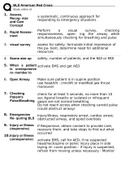BLS American Red Cross
Study online at
https://quizlet.com/_8fwdup
1. Assess,
a systematic, continuous approach for
Recog- nize
responding to emergency situations
and Care
Concept
Perform a visual survey, checking
2. Rapid Assess-
responsiveness, open- ing the airway while
ment
simultaneously checking for breathing and pulse
3. visual survey assess for safety, formulate initial impression of
the pa- tient, determine need for additional
resources
4. Scene size up safety, number of patients, and the NOI or MOI
5. When a patient activate EMS and get AED
is unresponsive
re- member to
6. Open Airway Make sure patient is in supine position
use head/tilt - chin/lift or modified jaw thrust
maneuver
7. Checking check for at least 5 seconds, no more than 10
Patient's sec Agonal breaths or isolated or infrequent
Pulse/Breathing gasps are not normal breathing
Do not reach across when checking carotid pulse
(could obstruct airway)
8. Emergencies Injury/Illness, respiratory arrest, cardiac arrest,
Re- quiring BLS obstructed airway, and opiod overdoes
9. Injury or Illness If Responsive, obtain consent to provide care,
(responsive) reassure them, and take steps to find out what
occurred
10.Injury or Illness
(unresponsive) activate EMS, call for AED, if no suspected
head/neck/spine or pelvic injury place in side
laying re- cover position - if injury is suspected,
refrain from moving unless necessary - Monitor
1/
, BLS American Red Cross
Study online at
patienthttps://quizlet.com/_8fwdup
until help arrives
11. ROSC Return of spontaneous
circulation 12.
2/
, BLS American Red Cross
Study online at
https://quizlet.com/_8fwdup
Respiratory Ar- patient is unresponsive, is not breathing normally
rest (or only gasping) but has a pulse.
13.How should you deliver 1 ventilation every 5 to 6 seconds, each
deliver ventila- ventilation should last 1 second and make chest
tion during begin to rise
respi- ratory
arrest
14. Cardiac Arrest Patient is unresponsive, not breathing normally
and does not have a pulse *start CPR within 10
seconds of recog- nizing cardiac arrest and use
AED when it's available
15. In-Hospital Car- Surveillance and prevention
diac Arrest Chain Recognition of a cardiac emergency and activation
of
of Survival Emergency response
system Early CPR
Early Defib
Integrated post-cardiac arrest care
16.Out-of-hospital Recognition of Cardiac Emergency and
Cardiac arrest Activation of emergency response system
early cpr
early
defib
advanced life support
integrated post-cardiac arrest care
17.myocardinal in-
farction (MI) Refers to the necrosis (death) of heart tissue as
a result of insufficient delivery of oxygenated
18.Signs and blood for the heart
Symp- toms of
MI chest discomfort/pain that is severe that lasts
longer than 3-5 minutes, goes away and comes
back or persists even during rest
Discomfort pressure or pain that can be
uncomfortable to unbearable, Crushing sensation
in the chest that could spread to the arm,
3/




